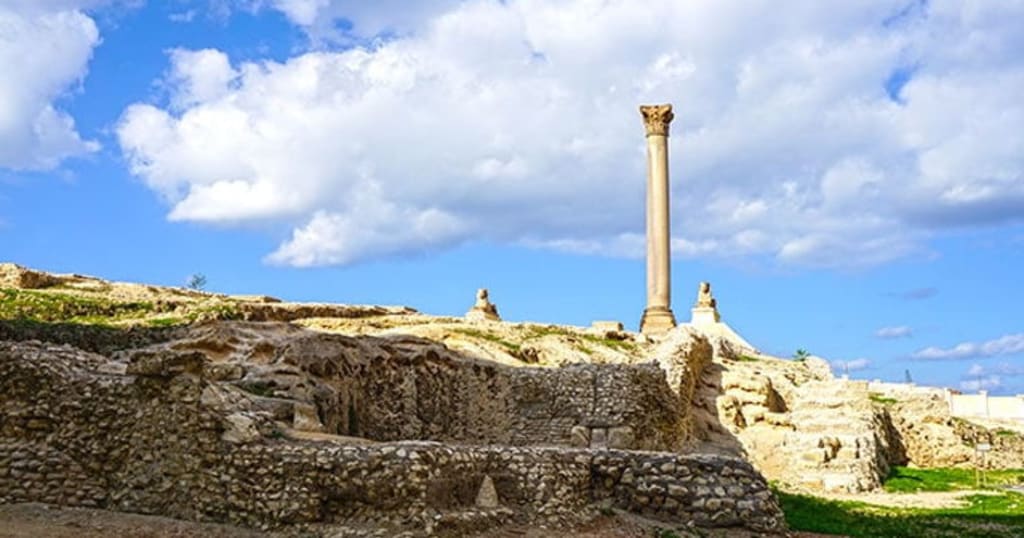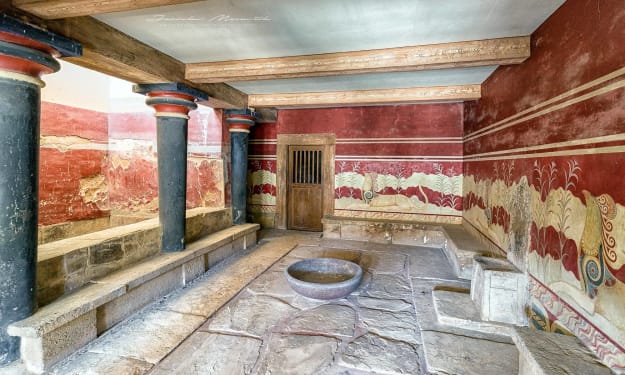The Serapeum of Alexandria: The Great Temple of Serapis
Egypt, Africa

The Serapeum was the largest and most prestigious of all temples in the Greek quarter of Alexandria, built during the reign of Ptolemy III Euergetes, built with white marble, and was decorated with reliefs and statues between 246 and 222 BC. It was dedicated to the Egyptian god Serapis that was invented by Ptolemy I to bind the native Egyptians with the Greeks
The site was a rocky plateau overlooking the sea which made it the largest and most impressive of all temples in Alexandria.
Unfortunately the Sarapeion was destroyed down to its foundations by Christians at the end of the fourth century. In 391 AD, Bishop Theophilus sent troops to specifically destroy the temple and a monastery dedicated to John the Baptist was built on the temple's ruins. The Christian mob destroyed the Serapeum and looted its treasures, the bleak remains of the grand structure lie within an archaeological park. Apart from the concrete foundations of a Roman building and a few column shafts lying on the ground, there is little left above ground, However, There are remains of the Sarapeion underground
The most well known and obvious remains of the Sarapeion is, of course, the gigantic column popularly known as Pompey's Pillar. The pillar has survived ancient earthquakes that demolished many of the Alexandria's ancient monuments such as the Pharos Lighthouse and it is the only ancient monument still standing in Alexandria. In fact, Pompey's Pillar is the only ancient monument left standing in its original location today
SERAPIS
Serapis was depicted as Greek in appearance but with Egyptian trappings, and the Statuette have the god Serapis in a throne with Cerberus, his three-headed dog. He is similar to many other statues. Such typical features include the frontal pose, the left arm raised and right outstretched, the costume of the sleeved chiton, the himation and the sandals, the large face with the beard, the long hair, the arrangement of hair on the forehead, and the modius (grain measure) on his head. The three headed dog Cerberus is also similar to the typology attributed to the Bryaxis statue. The god has the character of an oracle as symbolised by its open mouth. The statue was probably intended for a private setting, a domestic shrine and many similar ones have been found in Rome. The base with the overhanging lip would make it easy to display in a domestic setting. Serapis was a god associated with healing and death and had a strong personal appeal. Blundell identified the statue as Pluto because of the presence of Cerberus.
SERAPIUM AS A TOURISM DESTINATION
During the 19th century, like the Great Pyramid at Giza, climbing the column seems to have become a sport, and many travelers carved their names on the top of the capital. The Serapeum was a popular destination for pilgrims and tourist from all over the world. It was known for its healing powers, and many people came to the temple to seek cures for their ailments. The temple was also known for its fertility rites, and many couples came to the temple to pray for children. Visitors still go to the temple to worship Serapis and seek his help with their problems. The temple was also a learning centre and contained one of the largest collection of books in the city of Alexandria. commissioned by Ptolemy III. Till this day It portrays a symbol of the power and wealth of the Ptolemaic dynasty. The historical place sounds interesting to visit just to get a glimpse of what life was like in the ancient world and an insight of ancient Egypt's history and culture.
About the Creator
Ntokozo Mvuni
Interesting stories 📚
Read to get intrigued
Enjoyed the story? Support the Creator.
Subscribe for free to receive all their stories in your feed. You could also pledge your support or give them a one-off tip, letting them know you appreciate their work.






Comments
There are no comments for this story
Be the first to respond and start the conversation.